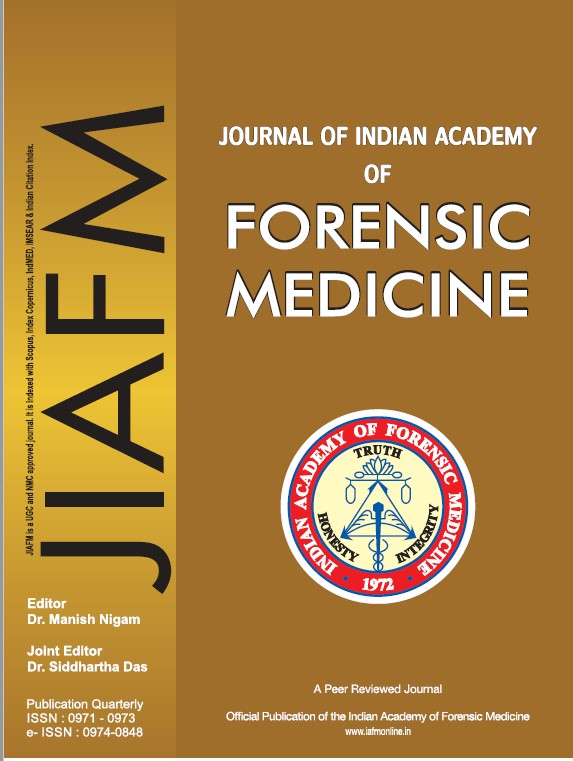Stature from Tibia Irrespective of Sex: A Cross-Sectional Study
DOI:
https://doi.org/10.48165/jiafm.2024.46.1.3Keywords:
Stature, Tibia, Correlation, Meitei, Regression equation, Irrespective of sexAbstract
Mutilated human remains are recovered many times and may be the only evidence of crime. Establishing the identity of the victim is of primary importance and stature assumes a prominent feature in the identification parameters. In view of this, we have taken up the present study to on Indigenous Manipuri Meitei subjects, both males and females, in the age group of 21-25 years. This is a cross-sectional study comparing the standing height of the participants with the percutaneous tibial length. The degree of correlation has been analysed and a regression formula has been estableshed irrespective of sex, i.e., which can be used on any specimen, whether male or female. Atotal of 75 males and 75 females were studied in Department of Forensic Medicine and Toxicology, of a tertiary health care centre in north east India. Subjects with any obvious congenital or acquired deformity of spine or extremities was not included in the study. Aregression equation is established based on the tibial length of the individual, irrespective of sex has been derived as, Y= 81.90 +.85 X3 + 4.11. The equation so developed is tested by F-test and found to be very highly significant (P=<.001). In other words, the developed equation is treated as best fit to the present data and henceforth it may be used to detect the stature of person too for any given value of his/her tibial length.
Downloads
References
Krogman WM, Iscan MY. The human skeleton in forensic nd medicine. Thomas CC. 2 Ed. Springfield;1986.58.
Badkur P, Nath S. Use of regression analysis in reconstruction of maximum bone length and living stature from fragmentary measures of the ulna. Forensic Sci Int. 2002;4(2):109-14.
Saini N, Chauhan S, Katara P, Parashar RA. Correlational study between stature and percutaneous tibial length in adult males and females of Rajasthan. IJBAMR. 2013;3(1):21-6.
Prasad R, Vettivel S, Jeyaseelan L, Isaac B, Chandi G. Reconstruction of the femur length from the markers of its proximal end. Clin Anat. 1996;9(1):28-33.
Gaur R, Kaur K, Airi R, Jarodia K. Estimation of stature from percutaneous lengths of tibia and fibula of scheduled caste individuals of Naraingarh area of Haryana. Ann Forensic Res Anal. 2016;3(1):1025.
Trotter M, Gleser GC. Estimation of stature from the long bones of American whites and Negroes. Am J Phys Anthropol. 1952;10(4):463-514.
Pelin IC, Duyar I. Estimating stature from tibial length: a comparison of methods. J Forensic Sci. 2003;48(4):708-12.
J Indian Acad Forensic Med. 2024 Jan-Mar 46 (1)
Dupertuis CW, Hadden JAJr. On the reconstruction of stature from long bones. Am J Phys Anthropol. 1951;9(1):15-53.
Ghosh T, Konar S. Estimation of stature from percutaneous length of tibia amongst Bengali population. Int J Res Med Sci. 2019;7:1767.
Sume BW. Estimation of body height from percutaneous length of tibia in Debre Markos University students, North West Ethiopia.Egypt J Forensic Sci. 2019;9:51.
Moitra S .Estimation of height from measurement of percutaneous tibial length in southern parts of West Bengal. Int J Anat Res. 2019;7(3-2):6891-95
SangeethaV, Khan TA. Prediction of Height from Percutaneous Tibial Length .NJBMS. 2018;8(3):127-30.
Martula L, Chongtham R, Ningthoujam DD. Estimation of stature from the percutaneous length of ulna & tibia in medical students of Nagaland. IOSR-JDMS. 2017;16(1):46- 52.
Anitha MR, Chaitra BR, Rajitta V, Bharathi D. Estimation of stature using ulnar length in living adult individuals in south Indian population. Indian J Clin Anat Physiol. 2016;4 (1):2139-41.
Banerjee M, Samanta C, Sangram S, Hota M, Kundu P, Mondal M, et al. Estimation of human height from the length of tibia. Int J Appl Basic Med Res. 2015;5(1):30-47.
Sheikhazadi A, Gholamreza H, Tahmineh M, Sheikhazadi E, Anary SHS, Qoreishy M. Stature estimation from percutaneous tibial height: study of Iranian medical students.
ISSN : 0971 - 0973, e - ISSN : 0974 - 0848
JBS Journal. 2015;2(2);121-4.
Trivedi A, Saxena S, Morya R, Jehan M, Bhadkaria V. Stature estimation using per-cutaneous tibial length in people of Gwalior region. IOSR-Journal of Dental and Medical Sciences. 2014;13(5):65-70.
Sah RP, Shrestha I . Estimation of stature from percutaneous length of tibia in the population of Birgunj, Nepal. JKMC. 2014;3(2):59-62.
Mohanty NK. Prediction of height from percutaneous tibial length amongst Oriya population. Forensic Sci Int. 1998;98:137-41.
Yayim Y. Estimation of stature from tibial length. J Forensic Med. 1996;12(1):87-93.
Steele D. Gentry. Estimation of Stature from Fragments of Long Limb Bones. T.D. Stewart ed. Personal Identification in Mass Disasters. National Museum of Natural History, Smithsonian Institution, Washington D.C., 1970:85-97.
Bhavna, Nath S. Use of lower limb measurements in reconstructing stature among Shia Muslims. The internet Journal of Biological Anthropology 2009;2(2):219-22. Available from: http://www.ispub.com/IJBA/2/2/12024. Accessed July 29, 2018.
Trotter M, Gleser GC. Are-evaluation of estimation of stature based on measurements of stature taken during life and of long bones after death. Am J Phys Anthropol. 1958;16:79- 123.


